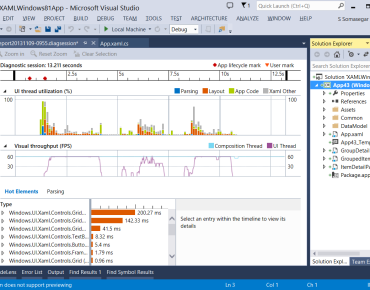Microsoft, SOASTA Enhance Visual Studio Family at Build 2015

Visual Studio Online, Microsoft
Visual Studio took center stage at Build 2015, Microsoft's annual conference for software and web developers.
For the first time, Microsoft has extended Visual Studio beyond Windows, with the introduction of Visual Studio Code that offers some capabilities on Windows, Linux, and Apple OS X.
Unveiled at Build 2015, Visual Studio Code is "a lightweight code-optimized editor" that integrates with Visual Studio Online, Microsoft's hosted service, said Scott Guthrie, executive vice president of the cloud and enterprise group at Microsoft, in a keynote presentation.
Available in dozens of languages, Visual Studio Code includes many features including the IntelliSense code suggestion tool and full support of the Git code management repository, he said. As such, the editor has the same code completion and formatting tools programmers are used to finding in Microsoft Visual Studio IDE.
Microsoft offers Visual Studio Code as a free download, with preview versions becoming available today at the Visual Studio homepage.
SOASTA Adds VS Online
Microsoft was not the only one making Visual Studio news at Build 2015. Performance analytics software developer SOASTA integrated its CloudTest and TouchTest solutions into Visual Studio Online to provide developers – both enterprise and ISV – with automated, ongoing testing of mobile and web applications. The new integration adds load and performance testing into the CI process; improves efficiency and quality, and delivers new insight into end-to-end performance and allows developers to identify and prioritize fixes, according to SOASTA.
Microsoft is a customer and now a partner, SOASTA CEO Tom Lounibos told Enterprise Technology. As more organizations adopt DevOps and want to speed up development, enterprises increasingly adopt performance analytics, he said.
"It's all about process compression. Everybody is focused on DevOps, that ability to push out new revs of your app in a more consistent basis and on a faster basis," Lounibos said. "We allow developers to use test automation, to actually do a lot more smoke testing and unit testing themselves; in other words, not wait for a tester to have the time to test, but run pretty sophisticated tests inside their environment and inside the Visual Studio environment. It gives them a lot more control and a lot more speed and ultimately a better customer experience. In our space it would be a lot of little tests. It allows you to do thousands of little tests rather than one big test."
Continuous integration enables developers to check how modules and components fit with their code early in the process, he said. Cloud allows enterprises to conduct microtesting continuously to reduce problems on test and live code, added Lounibos.
"Every application is different, but in a nutshell we're taking a process, let's say the testing process that used to take two or three days and literally reducing it to minutes. Individual tests are run in seconds," he said. "I'd say between 8 percent and 9 percent [of enterprises] use microtesting today; it's early innings. It's not just the technology. You have to have the people. You have to have the processes."
SOASTA integrates with DevOps solutions such as Atlassian, CA, CloudBees, IBM, Kony, Microsoft, and Serena, plus open source platforms like Jenkins and Travis CI, to tie cross-platform mobile test automation and performance analytics to continuous delivery approaches, the company said.
Related
Managing editor of Enterprise Technology. I've been covering tech and business for many years, for publications such as InformationWeek, Baseline Magazine, and Florida Today. A native Brit and longtime Yankees fan, I live with my husband, daughter, and two cats on the Space Coast in Florida.










